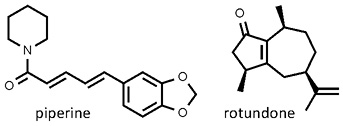 Piper nigrum
Piper nigrum
pepper • black pepper
Back to “Spices: black pepper (Piper nigrum)fr, fri; pepper (Piper nigrum)fr,fri”
Piper nigrum L. (Piperaceae); peper (Afrikaans); hu jiao (Chinese); poivre (French); Pfeffer (German); kaalii mirch (Hindi); merica (Indonesian); pepe nero (Italian); pappaa (Japanese); lada hitam (Malay); pimenta negra (Portuguese); pimienta (Spanish); phrik thai (Thai)
DESCRIPTION The fruits or drupes (peppercorns) are about 5 mm (0.2 in.) in diameter and may be green, black or white. All have a sharp, pungent taste and a delicious, spicy aroma when crushed.
THE PLANT A perennial vine or climber with hanging spikes of small flowers that turn into green and then bright red, fleshy drupes.
ORIGIN Indigenous to South India (Malabar region).1,2 Pepper featured prominently in the ancient world and was a source of fabulous wealth during the medieval and colonial spice trade. The Dutch and Afrikaans expression “peperduur” reflects the high price it once had. Pepper provided the pungency (“pep”) of Indian food until it was partially replaced by chilli peppers from the New World. It nevertheless remains the most important and popular of all spices in terms of overall value and trade volume.
CULTIVATION The vines are grown from cuttings, with trees or trellises for support. They thrive only in low-altitude tropical regions. Main suppliers are Vietnam, India, Indonesia, Brazil and China.
HARVESTING Near-ripe (green) or ripe (red) fruits are hand-picked and processed. Black peppercorns are made by briefly cooking the green fruits. The heat disrupts the cells and causes a gradual blackening through enzymatic oxidation of the drupes while they are slowly dried. Green peppercorns are made by pickling or rapidly drying or freeze-drying the green peppercorns to prevent fermentation and to retain the green colour. White pepper is made from fully ripe red fruits by fermentation (retting). The fleshy fruit wall becomes decomposed and easily removed (mechanically or chemically), leaving only the seed which is then bleached and/or sundried.
CULINARY USES Pepper (usually paired with salt) is a ubiquitous table condiment. A pepper grinder is useful because pre-milled pepper from a shaker can quickly lose much of its flavour. Black pepper is used in practically all savoury dishes and even in sweet ones. Famous examples include pepper steak, poivrade sauce, Pfefferkuchen and it is even sprinkled on fresh strawberries. Whole peppercorns are added to pickles and marinades, while white pepper typically goes with pale-coloured Chinese dishes and French white sauces. There are countless applications in home cooking as well as commercial food processing.
FLAVOUR COMPOUNDS The pungent principle is piperine (only 1% as hot as capsaicin from chilli peppers). Essential oil in the shrivelled fruit walls adds spicy aromas. White pepper is more pungent and has musty flavours resulting from the fermentation process. The peppery aroma is due to rotundone, a compound also found in Shiraz wines.3

NOTES Minor sources of pepper include Ashanti pepper (P. guineense), cubebs or tailed pepper (P. cubeba) and Indian long pepper (P. longum). In ancient times long pepper was the most important item of trade but it was gradually replaced by black pepper. Leaves of P. sarmentosum are the cha plu of Thai cuisine and those of P. auritum the hoja santa of Mexican cuisine. See Schinus molle for more types of “pepper”.
1. Mabberley, D.J. 2008. Mabberley’s plant-book (3rd ed.). Cambridge University Press, Cambridge.
2. Zeven, A.C. 1995. Black pepper. In: Smartt, J., Simmonds, N.W. (Eds), Evolution of crop plants (2nd ed.), pp. 407–408. Longman, London.
3. Wood, C., Siebert, T.E., Parker, M., et al. 2008. From wine to pepper: rotundone, an obscure sesquiterpene, is a potent spicy aroma compound. Journal of Agricultural and Food Chemistry 56: 3738−3744.